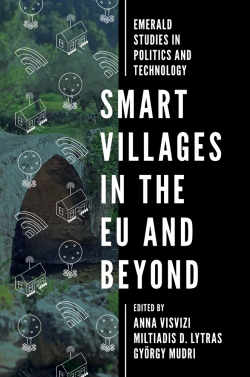In Smart Villages in the EU and Beyond, Anna Visvizi, Miltiadis D. Lytras and György Mudri bring together leading academics and practitioners to explore opportunities and challenges when it comes to innovating and developing rural communities — the ‘smart village’ approach. Drawing on inspiring case studies, the book offers numerous strategies and human-centred recommendations aimed at enabling a brighter future for rural communities around the world, writes Jochem Kootstra.
Smart Villages in the EU and Beyond. Anna Visvizi, Miltiadis D. Lytras and György Mudri (eds). Emerald Publishing. 2019.
The world is facing a period of increasing urbanisation. By 2050, two-thirds of the world’s population is projected to live in cities (currently 55 per cent). By then, the global population is expected to grow to nearly 10 billion. While this creates significant challenges for cities, it presents great opportunities for improving innovation and development in rural communities — the ‘smart village’ approach. The book Smart Villages in the EU and Beyond offers proactive methods to fight the implications of urbanisation by making villages more attractive and increasing their quality of life. But how do we do this without ending up urbanising rural areas?
This collection is the second volume in the series Emerald Studies in Politics and Technology, the first being Politics and Technology in the Post-Truth Era (again, very relevant). Edited by Anna Visvizi, Miltiadis D. Lytras and György Mudri, the book consists of twelve essays and case studies by leading academics and practitioners in the field of smart villages/cities, varying from engineers to political scientists, agronomists, architects, think tanks, institutions and advocacy groups. Because of this wide range of expertise, the book offers an almost complete image of both the challenges at the local level and for rural development, as well as the grand possibilities of a smart village-movement. But perhaps most importantly, it also contains everything in between, including concepts, definitions, policymaking initiatives, new business models based on the sharing economy, ICT frameworks, sustainable development models and, thankfully, the people.
Narrowing down all this expertise, Visvizi, Lytras and Mudri are ultimately seeking connections between research and policymaking for a smart village approach in different parts of our globe. As they write: they are ‘making a case for a conceptually sound, academically disciplined, empirically driven discussion on smart villages and its relevance and application in the policymaking process’ (3). By doing so, they continuously involve village inhabitants and civil society actors before making radical recommendations that affect local communities as the concept can be territorially sensitive. Therefore, the book is an interdisciplinary dialogue between all stakeholders. It consists of inspiring chapters on country field studies from Slovenia to South Korea, as well as thorough insights into conceptual backgrounds and the role of policymakers, small and medium-sized enterprises (SMEs) and other institutions. Without turning into tunnel vision, the aim is to make real progress in the policymaking process, offering territorially dependent, efficient and strong guidelines for adaptation and a brighter future for rural communities around the globe.
But the big question is, at least for me, ‘how to make rural life attractive, especially for the young generation’ (9), as Visvizi, Lytras and Mudri open the first chapter. As a 30-year-old, I live in a ‘big’ (smart) city, Amsterdam, and would still like to consider myself as part of the ‘young’ group. Moving out of the hectic city to a rural area where I can live in a self-sufficient tiny house is already on my agenda, but what makes it so tempting is, at the same time, what’s holding me back: disconnection — from the world and the internet. Paradoxically, the contributors give relevant and convincing solutions ‘to mitigate the digital divide between rural and urban areas and to develop the potential offered by connectivity and digitisation of rural areas’ (xviii). For example, smooth connections to broadband internet, but also enhanced potential for mobility and the participation of the SMEs/startups that are creating jobs, innovative ideas and services and making better use of knowledge (see Chapter Eight, ‘The Role of SMEs in the Smart Villages Concept’, by Xénia Szanyi-Gyenes). This is what could, and should, lure young people in.
At the same time, contributors including Raquel Pérez-del Hoyo and Higinio Mora also explore the question of resilience in rural areas, as inhabitants are very much open to a globalised world, resulting in the trend of migrating to the city. This increasing urbanisation has partly to do with the fact that ‘cities have a ‘‘pull effect’’ mainly due to the perception of increased educational and employment opportunities’ (50). The contributors propose methodologies on how to recover a system or habitat to its initial state when city values, like modern technologies and better education, are being added to the existing advantages of the village. By bringing together the assets of the countryside and the city, they try to limit reasons for leaving the village. Simultaneously, they respond to ‘the demands in all areas of life: personal development, health, well-being, security and leisure’ (51) that have been lacking in political actions. Again, these methodologies are formed in the interaction between rural communities, research groups and governing bodies, while recognising rural potential and identifying the development needs of rural areas.
By looking at the potential of rural communities and villages, the contributors present numerous strategies that involve sustainable and sharing methods, which particularly appealed to me. They delve into other sources of renewable energy with case studies from India, Germany and Rwanda. They also examine various means of agriculture and food production, smart farming and non-farming activities in South Korea, strategies for tourism in rural areas and the 6th industrialisation, and they namedrop almost all existing modern technologies to implement this: big data, data analytics, data mining, sensors, virtual reality, augmented reality, 5G, blockchain, etc.
Thankfully, contributors go beyond the tech hype in this book with strategies that focus on inhabitants: those that bring the village to life. The book embodies critical optimism, operating between people and technology. As Visvizi, Lytras and Mudri state:
while ICT-enhanced approaches are necessary to ensure well-being, safety and happiness of the inhabitants of villages, it is our obligation—in the spirit of, say it, solidarity—to ensure that villages are revitalised and regain the luster of attraction they deserve.
Visvizi, Lytras and Mudri recommend ‘a considerate and ethically and socially conscious use of ICT’ (3) and define the village as ‘an ecosystem, a microcosm, a community and people, rather than an aggregate, largely de-personalised construct’ (3). Yet, I’m not overly convinced. While ICT is necessary for wellbeing, safety and happiness, the opposite result may well occur. It wouldn’t be the first time that technology ends up being utilised for something completely different from its intended purpose by both its users and creators. I missed the healthy dose of tech criticality such that contributors can see where things might go wrong. They offer human-centred recommendations and they involve inhabitants in building smart strategies for their community, but the book left me with questions on how the contributors want to execute this without the big influence of tech companies. We have to be aware of top-down control and interference, and not simply maximising efficiency to be able to make smart villages work.
Making cities ‘smart’ has already received a backlash in The Netherlands and beyond, due to statements like ‘smart cities make dumb citizens’, or critical questions regarding privacy, agency, inequality, sustainability and democracy in relation to smart systems and big companies. And who or what is actually becoming ‘smart’ (is it the big tech companies?)? The same challenges and implications go, of course, for smart villages. Although the contributors acknowledge that we have to be careful of a smart hype, respectful of the initial assets of villages and involve inhabitants in decision-making and the chosen course of action, I still worry about big tech takeovers when SMEs are becoming a success in rural communities.
As the case studies involve inhabitants, I would also have loved to have read a chapter that examines, for example, surveillance capitalism and data control in smart villages, exploring open source software, a commons transition and peer-2-peer networks (to namedrop a few sharing technologies myself), working to a model where inhabitants themselves can own all data. I also wanted to read more about the narrative of the people, which would likely be different to the voices of academics, policymakers and technology that the book represents. Of course, the book is meant for the experts, but I hope they will use it to inspire laypeople, motivate citizens and develop further research.
Yet the contributing authors do acknowledge the important role of politicians as human guardians, not just the big (tech) companies. Without this role, these so-called ‘smart’ technologies and ‘smart’ companies will lead us to places that we never imagined could exist — which could also be for the worse. But if I were to be involved in helping to design smart strategies for the rural community where my future self-sufficient tiny house will be located, like the contributors propose, I would leave my beloved Amsterdam immediately.
Please read our comments policy before commenting.
Note: This article is provided by our sister site, LSE Review of Books. It gives the views of the author, not the position of EUROPP – European Politics and Policy or the London School of Economics.
_________________________________
Jochem Kootstra
Jochem Kootstra graduated cumlaude in 2017, researching the interdisciplinary relationship between technological engineers, posthuman artists and technology. With that, he won the Johannes van der Zouwen Master Thesis Award in the field of social sciences. He continues working as a researcher, writer and program maker at the intersection of emerging technology and art, with the purpose to move toward a more inclusive and humane future with technology.


 Find this book:
Find this book: 

